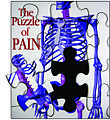 There are many types of pain. Muscle pain, tendon pain, ligament pain, joint pain, bone pain, dull pain, sharp pain, acute pain, referred pain, and chronic pain.
There are many types of pain. Muscle pain, tendon pain, ligament pain, joint pain, bone pain, dull pain, sharp pain, acute pain, referred pain, and chronic pain.
And that’s just off the top of my head. I am sure we could come up with a few more.
Teaching people to walk can be seen as a strange pursuit, so at the beginning of my practice, I pretty much saw only people who were in pain.
Years later I am working with athletes, actors, musicians, and others, as well as people in chronic pain. But the expansion to our online program that started ten months ago has brought into sharp focus just how many people out there are suffering from chronic debilitating pain and not getting relief from traditional methods.
While most of my early clients had pain issues nothing prepared me for the extent of pain out there in the world that goes undiagnosed and misdiagnosed, untreated, and mistreated.
Or the number of unnecessary surgeries (which is by no means all surgeries) that are performed each day; as well as the number of surgeries that are performed and do not work.
I have been powerfully humbled by the number of dialogues I have begun, and emails that I have received, and continue to receive daily, from people suffering from long-term chronic pain — caught in a cycle of pain, confusion, depression and a loss of hope.
If you are one of those people or know one of those people, here is a short primer on what needs to be done. We will start with the most important thing to realize and process.
No one can fix you but yourself. Even if you have a surgery that worked you will need to change the patterns that led you there.
You can go to the world’s most brilliant body workers but if you don’t work with them to adapt your body to the work they are doing, their work won’t last.
I love chiropractors, but if they adjust you and you simply go about your business without integrating their treatment through changes that you bring to your life, the treatment will not last.
• Not all pain can be healed.
There are congenital issues that afflict people that are not fixable, per se, but they can be supported.
Building muscle tone and improving one’s posture can go a long way toward maintaining an active sustainable life, even if the breakdown of your body is out of your control.
• Understand why you are in pain.
Everyone breaks down for a reason. It doesn’t simply “happen”.
I consider myself a body detective and there are always clues that lead to answers. In this context, congenital pain is the easiest to understand.
But all pain has a source and you must figure out why you started hurting. It can go back to injuries or illness from childhood, or be as simple as a broken pinky toe two years ago that you never paid any attention to.
However, there is always a reason and it is your responsibility (with the help of a good practitioner, if need be) to figure it out.
• You must move.
Movement is the essence of life and a sedentary life is a life not lived.
I watched this exact problem with both of my parents. My father was sedentary his whole life, never exercising a day with the exception of bringing cigarettes to his lips.
By the time he was seventy five, his body began to abandon him.
My mother’s case was different. She had a spinal fusion surgery that damaged the nerve to the outer thigh muscles and her walking has been compromised ever since.
Couple that with the depression of my father passing away and she has become as sedentary as him. The brain, let alone the body, does not do well with sedentary lifestyle.
• Avoid medication and surgery.
This is a tricky subject. For one I have nothing against western medicine and surgery.
I had three knee surgeries that I don’t regret, and I am pushing to have my daughters tonsils removed. If I found out that I had cancer tomorrow I would be open to the idea of chemotherapy.
But, that said, it is generally the job of doctors to prescribe medication (not all of course) and of orthopedists to perform surgeries.
Both of these should be options of absolute last resort. There are plenty of times when pain meds and cortisone shots can work, but more often than not they mask a pain that will only return with or without them.
That is not a true way to heal our bodies and all roads should be pursued before succumbing to a journey that can be hard to end once you begin.
• Chart your own proper course for healing.
Don’t trust someone because they have a degree or certificate. The world is filled with good and bad doctors, good and bad physical therapists, good and bad exercise teachers.
Be wary of who you trust. Be wary of who you believe.
You must be in charge of what you are doing to heal yourself and the responsibility for finding the right doctors/healers/body workers lies with you.
• Be willing to change.
I teach people to walk and correct their posture, but I am merely a guide who makes suggestions that people either have the discipline to follow through on or not. However, without change there is little chance of healing.
You must become a new you with a new posture, new movement patterns and a new balanced musculature if you want healing to be a lasting experience.
Good luck. I, and many others are here to help you, but you have be the force that moves your body towards a state of healing.
